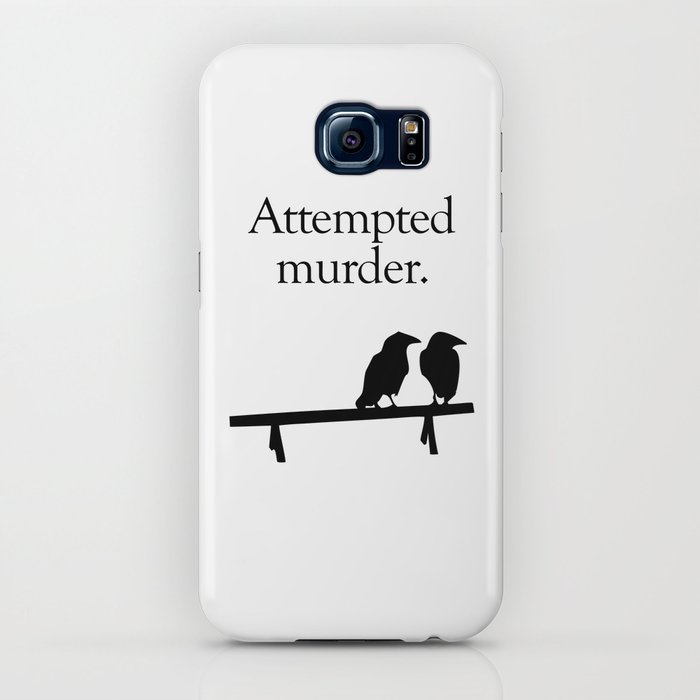Attempted Murder Iphone Case
attempted murder iphone case
SKU: EN-R10440

attempted murder iphone case
Apple's patent application, filed in 2013 but not published till Thursday, describes a new-look cellular hotspot that would capture a wireless carrier's cell signal, convert it to Wi-Fi and cast it out to wireless devices so they could connect to the Internet. Unlike many other hotspots, the Apple invention would ditch all buttons and turn on with a simple twist of one end of the cylindrical device, which the application describes as "compact."The patent seems to follow the design concept Apple has tried to bring to most of its devices and accessories: simplicity. That simplicity comes through in several Apple products, like the minimally buttoned Apple TV remote, the plug-and-play iMac computers and the touch-gesture-friendly Magic Mouse. Wireless hotspots that would potentially compete with Apple's invention typically come with a handful of buttons designed to help users connect to a network and other devices.
In Apple's patent application, the company specifically noted that its hotspot invention was designed to be simple in its functionality, When the hotspot is turned off, the two ends of the cylinder are in a neutral position, Twisting one end turns the signal on, allowing devices to connect, In addition to nixing buttons, the cylinder tucks all its critical components, like an antenna and power supply, inside, "The electronics, antenna and power supply are contained within the device," Apple writes in its patent application, "The cylindrical portions may be separated to access the internal components, The power supply is included in one of the cylindrical portions and may be interchangeable with power supplies of different capacities."One could question whether the hotspot is even necessary, While there are still wireless hotspots that connect a cell company's network to Wi-Fi-enabled devices, Apple's mobile devices, including the iPhone, can act as a cellular hotspot, So in effect they can achieve the same goal of sharing a wireless carrier's network with other products without requiring a user to buy a separate attempted murder iphone case device..
There are, however, some use cases where a separate wireless hotspot might make sense, like when a device such as the iPhone is unavailable. Whether the hotspot will ever make it to store shelves remains to be seen. Like other companies, Apple often files for patents on technologies that are never released. It's unknown whether its hotspot will join that group or if it will indeed be available at some point in the future. Apple declined to comment on the patent application. Patent application shows a simple cylindrical device that's turned on by twisting one end. Whether it will ever hit the market, though, is an open question.
The new figure comes from Morgan Stanley analyst Katy Huberty, who is raising her Apple Watch sales forecast by 20 percent from the earlier figure of 30 million, It might have been even higher if Apple were having attempted murder iphone case better luck with its supply chain for the smartwatch, its first foray into wearables, The market for smartwatches is a bustling one, with a wide array of options including the Samsung Gear S and Android-based models including the LG G Watch R and the Motorola Moto 360 , But while smartwatches from those and other companies have been on the market for months, none has yet lit up interest among consumers in the way that Apple's entry is expected to, In 2014, all smartwatch vendors combined shipped only 4.6 million devices, according to Strategy Analytics..
The Apple Watch is available in three different flavors -- the entry-level Sport version, the midlevel Apple Watch and the luxury Apple Watch Edition. The Sport version starts at $349, the Apple Watch at $549 and the Apple Watch Edition at $10,000. For the moment, they're available for purchase through Apple only by reservation at an Apple Store or via online sales, and can also be found in a sprinkling of luxury stores. The devices were back-ordered as soon as they went on sale in April, with delivery dates stretching into June and July. Apple hasn't revealed any numbers for initial sales (in contrast with its typical approach when a new iPhone goes on sale), and it's unclear how much of the delay stems from strength of consumer demand and how much from supply shortages or manufacturing issues.
- new ballet shoes pointe on sale
- dance ballet reusable stencil | multiple sizes to choose from
- 24 fonts- personalized ballet girl's quilted duffel bag by stephen joseph monogrammed free- birthday present, overnight bag
- sequin ballet slippers, gold, ivory, white, pink, blush, rose gold - flower girl shoes - baby and toddler girl - princess shoes
- svg cutting file-point your toes in the right direction ballet quote svg cutting file
- customize a iphone case
- frida kahlo iphone case
- strada series folio case for apple iphone 7 plus and 8 plus - soft opal
- 4smarts voltbeam wireless charging case for iphone 7 / 6s / 6 - black
- iphone 6s / 6 olixar sentinel case and glass screen protector
- atomic protective waterproof case for apple iphone 7 - silver/clear
- More...
